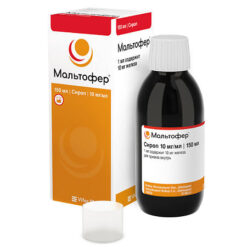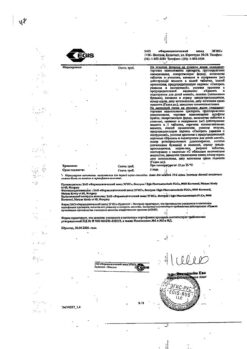No products in the cart.
Revolade 25 mg 28 pcs.
€1.00
Out of stock
(E-mail when Stock is available)
Description
Thrombocytopenia in patients with chronic ITP who have had insufficient response to corticosteroids, immunoglobulins and/or splenectomy. Revolade is indicated for these patients to reduce the risk of bleeding.
Active ingredient
Active ingredient
Composition
Composition
Active ingredient: eltrombopag olamina crushed;
Auxiliary substances: Mannitol; MCC; povidone K30; sodium carboxymethyl starch (type A); magnesium stearate; Opadry® White YS-1-7706-G (25 mg dosage tablets); Opadry® Brown 03B26716 (50 mg dosage tablets)
How to take, the dosage
How to take, the dosage
Ingestion at least 4 hours before or 4 hours after intake of antacids, dairy products or mineral supplements containing polyvalent cations (e.g. aluminum, calcium, iron, magnesium, selenium and zinc).
The drug Revolade can be taken with food containing small amounts of calcium (
The dosing regimen of Revolade is prescribed individually based on platelet count.
The lowest effective dose of the drug is used to maintain the clinically necessary platelet count.
In most patients, an increase in platelet count occurs after 1-2 weeks of treatment.
Adults. The recommended starting dose is 50 mg once daily. If, after 2-3 weeks of initial therapy, the platelet count is below the clinically necessary level (i.e., 50,000/μL), the dose can be increased to a maximum of 75 mg once daily. The standard downward or upward dose adjustment should be 25 mg daily. However, some patients may require a combination of different doses on different days.
After any dose adjustment of Revolade, platelet counts should be monitored at least weekly for 2-3 weeks. Expect a response from the patient’s platelet counts for at least 2 weeks after dose adjustment.
When platelet counts are 200000-400000/μL, it is recommended that the dose of Revolade be reduced.
The treatment with Revolade should be stopped if the platelet count exceeds 400000/μL. If the platelet count is less than 150,000/μL, treatment should be resumed at the reduced daily dose.
Particular patient groups
Children. The safety and effectiveness of eltrombopag in children have not been established.
Elderly patients. There are limited data on the use of eltrombopag in patients aged 65 years and older. In clinical studies of eltrombopag, there were no clinically significant differences in safety of the drug in patients aged 65 years and older compared to younger patients. However, hypersensitivity to the drug in some elderly patients has not been excluded.
East Asians. In patients who are residents and natives of East Asia and their descendants (e.g., Chinese, Japanese, Taiwanese, and Koreans), it is recommended to administer the drug in a reduced starting dose of 25 mg once daily. The patient’s platelet count should be counted. It is allowed to use standard criteria and recommendations for further dose adjustment.
Interaction
Interaction
Rosuvastatin: when co-administered with eltrombopag, consideration should be given to reducing the dose of rosuvastatin, and the patient should be closely monitored. In clinical trials of eltrombopag with concomitant therapy with rosuvastatin it was recommended to reduce the dose of the latter by 50%. Concomitant administration of eltrombopag and other substrates of OATP1B1 and BCRP requires caution.
Polyvalent cations (formation of chelate complexes): In order to avoid significant decrease in absorption of eltrombopag, the drug should be taken at least 4 h before or after taking antacids, dairy products and other substances containing polyvalent cations (for example, mineral supplements containing aluminum, calcium, iron, magnesium, selenium and zinc).
Food: Taking a single dose of eltrombopag 50 mg with a standard high-fat, dairy-rich breakfast reducesAUCo-â by 59% (CI 90%: 54 and 64%) and Cmax by 65% (CI 90%: 59 and 70%). Foods with low calcium content (
Special Instructions
Special Instructions
The efficacy and safety of eltrombopag for the treatment of other diseases and conditions accompanied by thrombocytopenia, including thrombocytopenia after chemotherapy and myelodysplastic syndromes, are currently unknown.
Liver function monitoring
The use of eltrombopag may cause abnormalities in laboratory measures of liver function. Increases in serum ALT, ACT and indirect bilirubin levels have been noted in clinical studies. These phenomena were mostly mild (grade 1-2) and reversible without clinically significant symptoms that would indicate impaired liver function. According to two placebo-controlled studies, adverse events in the form of increased ALT levels were observed in 5.7% and 4% of patients treated with eltrombopag and placebo, respectively. Serum ALT, ACT, and bilirubin levels should be assessed before starting treatment with eltrombopag, then monitored every 2 weeks during dose titration, and monthly after stable dose administration. Repeated investigation after detection of liver function tests deviation is performed within 3-5 days. If deviation is confirmed, monitoring continues until the phenomenon is resolved, stabilized or the values return to the baseline. Treatment with eltrombopag shall be stopped in case of ALT level increase (â¥3-fold increase of BHN value and presence of the following symptoms:
– progression of the abnormality, or
– persistence of the abnormality for â¥4 weeks, or
– its combination with elevated levels of direct bilirubin, or
– its combination with clinical symptoms of liver damage or signs of decompensation of liver function.
Patients with impaired liver function should be prescribed eltrombopag with caution. In patients with moderate or severe hepatic impairment, the initial dose should be 25 mg once daily.
Trombotic/thromboembolic complications
A higher than normal platelet count represents a theoretical risk of thrombotic/thromboembolic complications. In clinical studies of elthrombopag, thromboembolic complications have been observed in low and normal platelet counts. In studies of idiopathic thrombocytopenic purpura, 21 episodes of thromboembolism were observed in 17 of 446 patients (3.8%). Thromboembolisms included: embolism, including pulmonary embolism, deep vein thrombosis, transient ischemic attacks, myocardial infarction, ischemic stroke, and suspected prolonged reversible ischemic neurological deficit.
Thrombotic/thromboembolic complications can result from very significant increases in platelet levels. Patients with known risk factors for thrombotic/thromboembolic complications (such as factor V Leiden mutation, ATIII deficiency, antiphospholipid syndrome, etc.) should be given special consideration when prescribing eltrombopag.
The platelet count should be monitored carefully and consideration should be given to reducing the dose or discontinuing eltrombopag if the platelet count exceeds the target values.
In a controlled study involving patients with thrombocytopenia and chronic liver disease (n = 288) who underwent elective invasive interventions, the risk of thrombotic complications was increased in patients who received eltrombopag at a dose of 75 mg once daily for 14 days. There were 6 thrombotic complications in the group of patients receiving eltrombopag and 1 in the placebo group. All thrombotic complications noted in patients in the eltrombopag group were in the portal vein system.
Bleeding after discontinuation of eltrombopag treatment
After discontinuation of eltrombopag treatment, most patients’ platelet counts return to baseline within 2 weeks, which increases the risk of bleeding and in some cases may cause bleeding. Platelet counts should be monitored weekly for 4 weeks after eltrombopag withdrawal.
Bone marrow reticulin formation and risk of bone marrow fibrosis
Trombopoietin receptor agonists, including eltrombopag, may increase the risk of formation or overgrowth of reticulin fibers in the bone marrow. Peripheral blood smears should be evaluated before starting treatment with eltrombopag to determine the baseline level of morphologic cellular changes. After a stable dose of eltrombopag is achieved, a monthly general clinical blood count with leukocyte formula counting is performed. If immature or dysplastic cells are detected, peripheral blood smears should be examined for new or increased morphological changes (e.g., the appearance of drop and nuclear erythrocytes, immature leukocytes), or for cytopenia. If a patient develops new or worsens existing morphologic abnormalities or cytopenias, discontinue treatment with eltrombopag and consider a bone marrow biopsy, including smear staining to detect fibrosis.
Malignant neoplasms and the progression of malignant neoplasms
There is a theoretical possibility that thrombopoietin receptor agonists may stimulate the progression of existing hematologic neoplasms such as myelodysplastic syndrome. No differences in the incidence of malignancies or malignant blood neoplasms have been shown in clinical trials between patients who received placebo and patients who received eltrombopag.
Cataracts
In toxicology studies of eltrombopag, cataracts have been found in rodents. The clinical significance of this sign is unknown. Routine monitoring of patients for cataracts is recommended.
The effect on the ability to drive or operate machinery
There have been no studies on the effect of eltrombopag on the ability to drive or operate machinery. Based on the pharmacological properties of eltrombopag, adverse effects on such activities are not expected. However, the patient’s clinical condition and the adverse event profile of eltrombopag should be considered when evaluating the patient’s ability to perform activities that require quick thinking, motor and cognitive skills.
Contraindications
Contraindications
With caution: impaired renal function, liver function; pregnancy; lactation; risk factors for thromboembolism (e.g., factor V Leiden deficiency, antithrombin III, antiphospholipid syndrome).
Side effects
Side effects
Infections and invasions: often – pharyngitis, urinary tract infections.
Gastrointestinal tract: very often – nausea, diarrhea; often – dry mouth, vomiting.
Liver and biliary tract disorders: often – increase of AST and ALT levels.
Skin and subcutaneous fatty tissue: often – alopecia, rash.
Musculoskeletal and connective tissue disorders: often – back pain, chest pain of musculoskeletal character, musculoskeletal pain, myalgia.
Overdose
Overdose
Symptoms: one case of overdose has been reported in clinical trials when a patient ingested 500 mg of eltrombopag and the following symptoms were noted: non-spreading rash, transient bradycardia, fatigue and increased transaminase levels. These changes were reversible.
In case of overdose, there may be a significant increase in platelet counts, which may lead to thrombotic/thromboembolic complications.
Treatment: In case of overdose, oral medications containing metal cations, such as calcium, aluminum, or magnesium, should be considered to reduce absorption of eltrombopag. Platelet counts should be monitored carefully. Treatment with eltrombopag should be resumed according to dosing recommendations.
Because renal excretion is not the primary route of elimination of eltrombopag, which actively binds to plasma proteins, hemodialysis is probably not an effective method of significantly accelerating elimination of eltrombopag from the body.
Additional information
| Shelf life | 3 years |
|---|---|
| Conditions of storage | At a temperature not exceeding 30 °C |
| Manufacturer | Glaxo Operations UK Ltd, UK |
| Medication form | pills |
| Brand | Glaxo Operations UK Ltd |
Related products
Buy Revolade 25 mg 28 pcs. with delivery to USA, UK, Europe and over 120 other countries.















